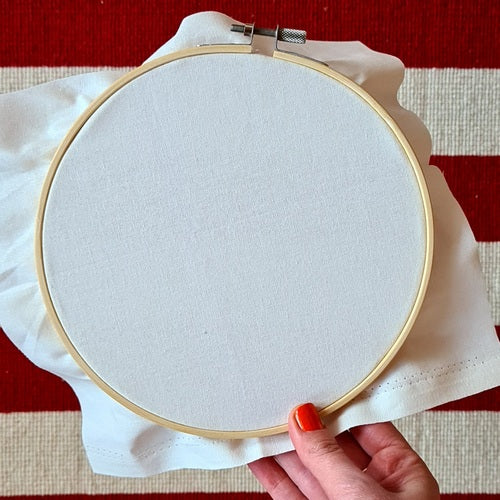
Embroidery can be done on a range of different fabrics - but there's certain things to look for when you want to start stitching!
For me, the best fabric for hand embroidery (which I include in most of my hoop and banner kits) is Klona cotton. This is a medium weight craft cotton - which means it's thick enough to prevent stretching, while being thin enough to easily pass a needle through.
If you're looking for your own fabric to embroider on, this brief guide can show you which materials work best for embroidery - and which ones to avoid!
Fabric types and weights
The weight of a fabric is essentially it's thickness. I always work with a medium weight fabric - too thin, and the fabric will stretch too much; too thick and it'll be hard to work with. Forcing a needle through thick material can be really tough on the hands - so I always prefer a medium weight fabric!
Fabric weights are usually measured in gsm (g/m²) - the higher the number, the heavier and thicker the fabric will be. Klona cotton is around 160 gsm and works brilliantly for me.
Poplin (a mixture of cotton and polyester) is around 120 gsm, and I find this too thin - it's prone to puckering under a lot of stitches. Drill cotton is around 260 gsm and is quite heavy - I prefer something a bit lighter!
There's loads of medium weight fabrics to choose from - other than Klona, I love to use Calico, Linen, and other Polyester blends. These fabrics are also very forgiving - if you need to undo a row of stitching, the fabric barely shows it!
Try to avoid any jersey, knitted fabrics, spandex and nylon blends, and satin (which is really hard to hide mistakes on!).
If you're not sure, try to pop into a fabric shop and have a feel! Usually the fabric weight will be printed on the label, or on the end of the roll - so you can easily compare how they all feel.
Fabric Colour
You can stitch on any colour fabric!
Klona, calico, linen, and other cottons come in all sorts of colours - so it's totally up to you!
The only thing to consider is how you'll transfer your pattern on to the fabric. Designs can be stencilled onto light fabrics with coloured carbon paper or water soluble fabric pens. Transferring patterns onto dark fabrics is best done with white or yellow carbon paper - If you've never done this before, check out my tutorial page showing how to use carbon paper.

Aida and Hardanger Fabric
If you've done any cross stitch, you'll be familiar with Aida fabric.
Aida has a clear square pattern, which makes it easy for counting stitches in cross stitch.
Aida fabric can also be used in Hardanger embroidery (a Scandinavian style) and Blackwork. The squares mean that it's great for creating geometric, symmetrical patterns. I prefer to use fabrics where the weave isn't so obvious - so Aida isn't the one for me. It totally depends on the effect you want to create, though!

Embroidering on clothes, home textiles and accessories
One of my favourite things about embroidery is that it doesn't have to stay in a hoop - you can use it to jazz up clothes, tote bags, and other home furnishings too!
If you want to embroider on to clothing, try to choose an item that is non-stretchy - like a good cotton blouse, or even a denim jacket (even though they're quite thick!). Make sure you've washed it beforehand, in case it changes shape in the first wash.
It's possible to embroider on more stretchy items (like T-shirts) too - but it's best to stabilise the fabric first. A stabiliser is something applied to fabric that stops it from warping or puckering under your embroidery. Stabiliser is also known as interfacing. Interfacing comes in light, medium, and heavy weights - try to choose one a similar thickness to your fabric.
I like to use fusible (a.k.a 'iron-on') interfacing, which can be ironed on before you start stitching, to support the fabric and help it to keep its shape. The only downside is that it can sometimes show through on thinner fabrics (like a white shirt)!
If you're worried about the stabiliser or interfacing showing through your fabric, it's best to use a water soluble stabiliser. These can be washed away once you're done, leaving very little trace!

If you have any questions about which fabric to embroider on, let me know using the comments section below!
